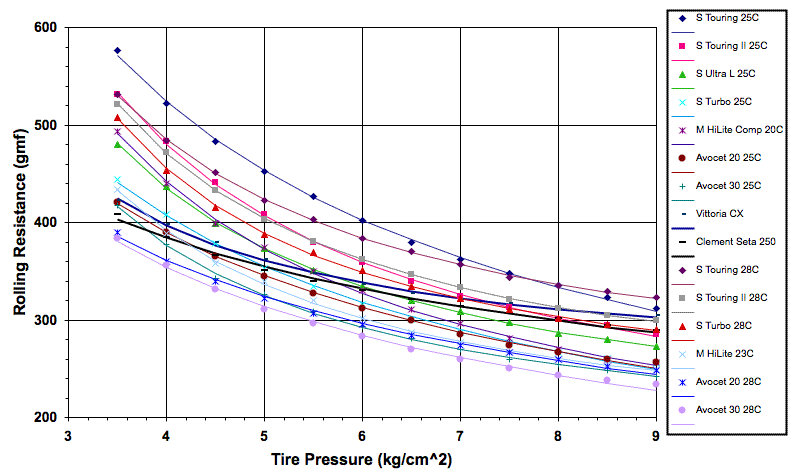

|
Subject: Rolling Resistance of Tubular Tires
From: Jobst Brandt
Date: Date: December 21, 2004
Rolling resistance or rolling drag caused by flexing tires has been misunderstood, judging from some tires found on the market. The cause of rolling resistance has at times been attributed to scrubbing between tread rubber and road, when in fact it arises almost entirely from flexing of rubber, or better yet, the elastomers in a tire. This includes the binder between casing cords, tread rubber, and inner tube rubber, all of which flex and absorb energy.
Most elastomers (mainly forms of rubber in this case) have hysteresis, meaning they do not rebound with the same force with which they are compressed. As a tire rotates into contact with the road, its deformation requires more force than is returned when it lifts off again. This puts the center of pressure ahead of the center of the contact patch. In contrast, sitting still, the center of pressure lies in the center of the contact patch.
This effect makes the wheel perform as though it were rolling up a slight incline, even though the road is level. This effect can be measured in various ways, the most obvious of which is to measure drag directly with a scale, a method that is difficult. Another method is to record the time a loaded freely rolling wheel on a test drum takes to coast to a lower speed, typically from twenty to ten miles per hour. With a calibrated load and drum, rolling resistance can accurately be determined from the measured time.
IRC (Inoue Rubber Co.) tested a series of tires at the time that its smooth-tread tires were being introduced in the USA by Avocet. The goal of these tests was to show that slick tires had lower rolling resistance than similar tires with grooved tread patterns, and in particular, tires that had a raised center rib that was intended to reduce rolling resistance by making less contact with the road.
The results were plotted on graphs that showed differences, and did so convincingly because each tire was tested over a range of inflation pressures. This gave curves that show consistency of measurement and tire response to inflation, instead of giving one value per tire.
The graph shows something that had previously been a mystery in the days when tubular tires were still commonly used. Tubular tires are attached to rims with glue that is offered in two main kinds" reusable, tacky glue which allows tire changes on the road, and hard glue used primarily on race tracks. From the Italian labels, Tipo Strada and Tipo Pista for road and track, the use was obvious... but why?
![]()
![]()
The reason for track glue became apparent in the graph that shows two high-quality racing tubulars, known have excellent performance. These two tires had a higher rolling resistance than thicker clincher tires whose similar curves could more-or-less all be generated from a single tire by multiplying its rolling resistance and re-plotting the data. However, they showed by their flat response to inflation pressure that they had low rolling resistance and that something else was occurring. Their offset was caused by something that does not respond to inflation pressure, losses from squirming on rim glue.
That tubular tires move on rims, and often wear through their base tapes where they bear on the glued rim, was known, but that it made a significant difference in rolling resistance was not.
Hard tubular glue prevents visco-elastic motion between tire and rim. From the existence of hard glue, this effect was apparently understood in the early days of racing, becoming a misunderstood oddity after WWII. Much of the technology that was present in those days was not recorded or handed down to the next generation. Interestingly the question about the two types of rim glue was answered in these rolling resistance tests long after common use of these tires had passed.

![]()
![]()
More Articles by Jobst Brandt
Next: Tubular Fables
Previous: Mounting Tubular Tires
![]()
![]()
Last Updated: by John Allen